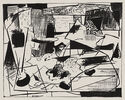
19th, 20th & 21st Century Fine Prints
707-546-7352 · fax 707-546-7924 · web: www.annexgalleries.com · email: artannex@aol.com
Wilfrid M. Zogbaum Biography
Wilfrid M. Zogbaum
American
1915–1965
Biography
Wilfrid Meynell Zogbaum, sculptor, painter, printmaker, photographer, and teacher, was born in Newport, Rhode Island in 1915. He was the son of an admiral and the grandson of Rufus Fairchild Zogbaum, an artist-illustrator who covered the Spanish-American War. As a child, Zogbaum traveled extensively in Europe and spoke French and German fluently. In high school, he spent two summers studying painting and drawing at the Rhode Island School of Design. In 1933 he enrolled for a year at the Yale School of Art and then left for to New York where he studied initially with John Sloan.
Beginning in 1935, Zogbaum attended the Hans Hofmann School of Fine Arts, where he served as a class monitor. In his 1964 interview with Dorothy Seckler, Zogbaum described Hofmann as “the only prophet of modern art in America.” He believed, as did Hofmann, in the importance of nature within art.
In 1936, Zogbaum was a founding member of the American Abstract Artists and the following year he was awarded a Guggenheim Fellowship to Europe. Zogbaum met Ben Nicholson, Naum Gabo, and Laszlo Moholy-Nagy in London. In Paris he met Wassily Kandinsky and developed a close friendship with Fernand Léger, a relationship that continued after the Frenchman fled to New York to escape the war. Zogbaum spent most of his fellowship year in Bavaria, where he associated with Fritz Winter and other former Bauhaus teachers. Returning to New York, Zogbaum painted independently for two years.
Zogbaum joined the U.S. Army Signal Corps in 1942 and served as a photographer. He was with the U.S. troops and recorded the liberation of the Pacific islands. During the late 1940s, he became a successful commercial photographer in New York. Zogbaum gave up his commercial career in 1948 to devote himself full time to his art. He exhibited frequently during the 1950s in group and solo exhibitions, and became well known as an Abstract artist.
During the mid 1950s, Zogbaum began making sculpture, initially as a supplement to his painting, and for several years divided his time between the two media. By the late 1950s, he only worked in sculpture. In the 1964 interview with Seckler, he is quoted as stating: Most of my sculpture has been made with the methods and materials at hand. One of these is the beach-stone which seemed a means of introducing a solid volume into the open cage-like structure of steel. At first it was used as a head-like part in a somewhat human or animal image. Later in a more abstract sense and in counterpoise with other objects within the image in a variety of meanings.
In 1957 Zogbaum taught for a semester at the University of California Berkeley. This position was followed by short-term teaching posts at the University of Minnesota, Southern Illinois University, and at Pratt Institute in New York, and a return year at the University of California Berkeley in 1961 – 62.
Wilfrid Zogbaum is represented in the collections of the Baltimore Museum of Art, Maryland; the Brooklyn Museum, New York; the David Owsley Museum, Ball State University, Muncie, Indiana; the Museum of Modern Art and the Whitney Museum of American Art, New York; the Baker Museum, Naples, Florida; the Pennsylvania Academy of the Fine Arts, Philadelphia; the San José Museum of Art, California; the San Francisco Museum of Modern Art, California; the National Gallery and the Smithsonian American Art Museum, Washington, D.C.; and the Davis Museum at Wellesley College, Massachusetts.
Wilfrid Meynell Zogbaum died in New York City on 7 January 1965, the day after his exhibition opened at the Grace Borgenicht Gallery.

